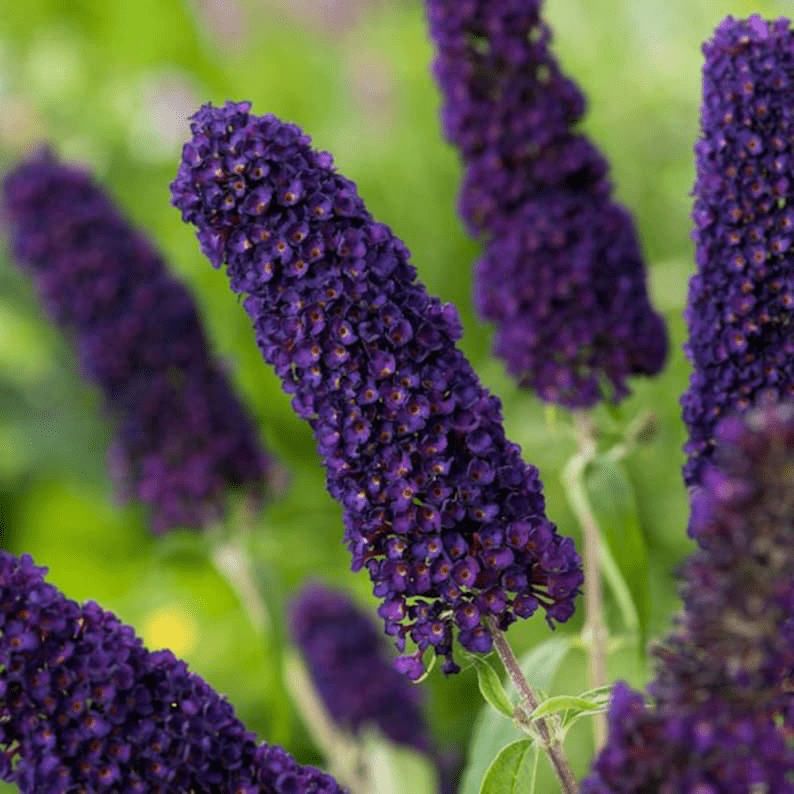
Black Knight
The Butterfly Bush ‘Black Knight’ (Buddleja davidii ‘Black Knight’) is a popular variety known for its stunning deep purple flowers and its ability to attract butterflies and other pollinators. Here’s some specific information about the Black Knight variety:
- Planting time: It’s best to plant the Black Knight butterfly bush in the spring or fall when the weather is mild. Avoid planting during extreme heat or frost.
- Size: The Black Knight butterfly bush can reach a mature height and width of around 6 to 8 feet (1.8 to 2.4 meters), so make sure to provide enough space for its growth.
- Sunlight requirements: Like other butterfly bushes, the Black Knight variety thrives in full sun. Ensure it receives at least 6-8 hours of direct sunlight each day for optimal growth and flowering.
- Soil type: Butterfly bushes are adaptable to a variety of soil types but prefer well-draining soil. If your soil is heavy or clayey, consider amending it with organic matter to improve drainage.
- Watering: Water the Black Knight butterfly bush regularly during the first growing season to establish its root system. Afterward, it is generally drought-tolerant and requires watering only during prolonged dry periods.
- Pruning: Prune the Black Knight butterfly bush in early spring before new growth emerges. Cut back the previous year’s growth to about 12-18 inches (30-45 cm) above the ground to encourage vigorous branching and a more compact shape. Deadheading spent flowers throughout the blooming season can also promote continuous flowering.
- Fertilization: Butterfly bushes are not heavy feeders, but you can apply a balanced slow-release fertilizer in early spring to provide nutrients for healthy growth. Follow the instructions on the fertilizer packaging for the appropriate application rates.
- Winter care: In colder regions, the Black Knight butterfly bush may die back to the ground in winter but will usually regrow in spring. Applying a layer of mulch around the base of the plant can help protect the roots during colder temperatures.
Remember to check your local regulations before planting butterfly bushes, as they can be considered invasive in some areas. If you live in a region where the Black Knight butterfly bush is not recommended, consider planting native alternatives that attract butterflies and other pollinators.
Care guide
Here’s a step-by-step guide to growing a butterfly bush (Black Knight variety):
- Choose the right location: Butterfly bushes thrive in full sun, so select a spot in your garden that receives at least 6-8 hours of direct sunlight per day. Ensure the soil is well-draining and fertile.
- Prepare the soil: Before planting, loosen the soil in the chosen area by digging it up and removing any weeds or grass. Incorporate organic matter like compost or well-rotted manure into the soil to improve its fertility and drainage.
- Dig the hole: Dig a hole that is slightly larger and deeper than the root ball of the butterfly bush. Make sure the hole is wide enough to accommodate the spread of the roots.
- Plant the butterfly bush: Place the butterfly bush in the center of the hole, ensuring that the top of the root ball is level with or slightly above the surrounding soil. Backfill the hole with soil, gently firming it around the roots as you go.
- Water thoroughly: After planting, give the butterfly bush a deep watering to settle the soil and help the roots establish. Provide enough water to saturate the root zone but avoid overwatering, as butterfly bushes prefer slightly drier conditions once established.
- Mulch the area: Spread a layer of organic mulch, such as wood chips or shredded bark, around the base of the plant. Mulch helps to retain moisture, suppress weed growth, and regulate soil temperature. Leave a small gap around the stem to prevent moisture-related issues.
- Watering and maintenance: Water the butterfly bush regularly, especially during dry spells, until it becomes established. Once established, it generally requires watering only during prolonged droughts. Prune the plant in early spring to remove any dead or damaged branches and encourage new growth.
- Fertilization: Apply a balanced slow-release fertilizer in spring, following the manufacturer’s instructions. This will provide essential nutrients for healthy growth and abundant blooms.
- Deadheading: To promote continuous blooming, deadhead faded flowers by removing them at their base. This encourages the growth of new flower spikes.
- Winter care: In colder regions, butterfly bushes may require protection during winter. Apply a layer of mulch around the base of the plant to insulate the roots and consider covering it with burlap or a frost blanket if severe cold is expected.
By following these steps, you can successfully grow and enjoy the beautiful blooms of the butterfly bush (Black Knight variety) in your garden. Remember to check local regulations as butterfly bushes can be considered invasive in some areas.





